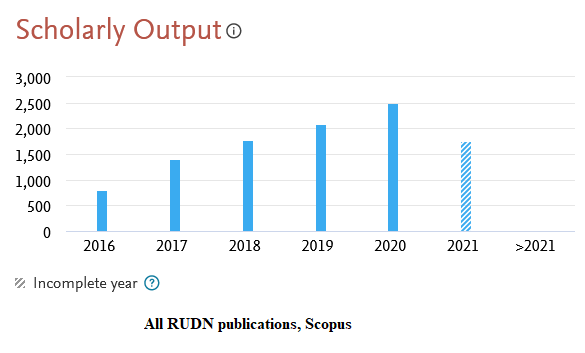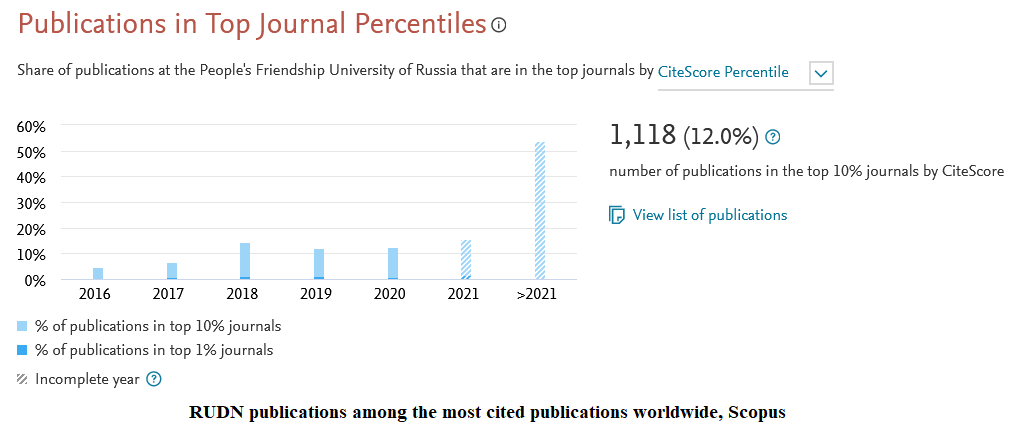RUDN University and Elsevier: 6 years of successful cooperation
RUDN is proud of
According to Scopus statistics, over the past 6 years:
- The number of articles in highly ranked journals in the first quartile (Q1) and second quartile (Q2) has increased more than 10-fold.
- Publications with international collaboration have increased 9-fold.
- The number of citations have increased almost 12-fold.
Back in 2016, only two RUDN journals were indexed in Scopus and Web of Science, but in 2021, there are already 14 of them.
Strategy, personnel and editorial policy — the heart of the development roadmap
RUDN has developed a new model of publication activity management. To implement the model, it was necessary to create a comprehensive publication strategy. Strategic sessions and targeted seminars with faculty and institute representatives on deep scientometric analysis basis came to the rescue.
Galina Yakshonok, analytical consultant for Elsevier S&T in Russia, the Republic of Belarus.
Together with colleagues from RUDN, a SWOT analysis was conducted. We identified strengths and weaknesses, new development prospects and formed requirements for the necessary analytics. The key objectives were formulated:
Increase the citation rate of publications in priority areas.
Increase the number of publications in Q1 journals.
Increase the share of publications in the world’s topical areas.
Increase the informativeness of Elsevier resources available to RUDN for the preparation of scientific articles in priority areas, optimize subscriptions.
Based on RUDN requests, Elsevier prepared an analytical report on the subject disciplines Chemistry, Mathematics, and Linguistics. The report included a detailed evaluation of the subject areas according to the key publication indicators: number of publications, citation indices, current share of publications in the highly cited areas, and author’s h-index (Hirsch index). A comparative analysis with reference universities was carried out, the current world subjects and the top cited journals in the selected fields were determined.
Analytical methods have become part of the research establishment work. Scientometrics staff members track the number of authors’ publications in RUDN as a whole, in specific subject areas, specific types of publications, citation growth, and the dynamics of the h-index; analyze how many publications are written jointly with foreign scientists; and which are included in the world’s most cited journals.
Nur Kirabayev, advisor on Scientific Activities to the Rector of RUDN (since 2020), Vice Rector for Research (2006-2020).
There is no national science, just as there is no national multiplication table. The university’s approach to publication activity has been planned according to RUDN scientific reputation enhancement program roadmaps. Scientific reputation is about the value of an interested search for truth, freedom of research and teaching; this value is not simply produced by the academic community, but is supplied “in the whole package” of university management’s offerings. In addition, academic reputation is formed and developed as part of the internationalization of research activities, including the academic mobility, publication activity in highly-cited journals and in cooperation with the business community and industry. A university’s strong reputation is usually ensured through the development of information structures, i.e. mechanisms for forming and developing a positive image for various consumer groups, which is reflected in the “Success Stories” rubric on the website of Elsevier. All of this is taken into consideration during the analysis of scientific potential.
Success Stories
- In Russia, collaborating across boundaries to tackle the global scourge of diabetes
An interview with a leading cardiovascular disease researcher, Prof. Zhanna Kobalava, MD, RUDN University.
- Transforming chemistry research to solve tomorrow’s challenges
An interview with Leonid Voskressensky, Dean of the Faculty of Physics, Mathematics and Natural Sciences, RUDN, PhD.
- Vibrating reality ... so what?! (Ask Victor Burenkov)
An interview with Professor Victor Burenkov, PhD, RUDN about the real-world applications of functional analysis and differential equations.
Over the past 6 years, indicators of the number and quality of scientific articles have increased, the overall publication structure of the university has changed and the articles in the authoritative journals of Q1 and Q2 quartiles have begun to occupy a greater part.
A quartile is the ranking of a journal or paper defined by any database based on the impact factor (IF), citation and indexing of that particular journal. It is determined by bibliometric indicators that reflect the level of citation. This determines the demand for the journal by the scientific community. The first and second quartiles journals are the most authoritative.


.png)
Focus on human resources: developing skills and competencies to work with digital tools, analytical databases
All employees involved in the research process had to acquire skills to work with specialized digital resources and Elsevier information and analytical platforms: ScienceDirect, Scopus, SciVal, Reaxys, Mendeley.
Dozens of round tables and meetings with Elsevier management have been held over the past 5 years; Elsevier experts have held more than 80 events specifically for RUDN University. More than 3,000 students and scientists took part in them.
Together we’ve figured it out:
- The intricacies of Elsevier software products, their functions, and features.
- The specifics of different disciplines and topics in the presentation of research results and the development of international collaborations.
- Which key journal metrics characterize a publication’s citation potential.
- How to choose the right scientific journals and avoid “predatory” ones.
This has allowed RUDN to adapt the culture of working with digital resources in its work processes. The level of using the full-text ScienceDirect database and the number of article downloads grow every year, which suggests that a successful culture of using digital resources in RUDN work and research processes has been implemented.
In 2020, a joint initiative was launched, that is, a school of scientometrics for the research establishment management staff. Elsevier experts shared their experience in collecting data for the most frequently requested reports and presented their vision of a competent approach to selecting metrics, sources, and analysis tools for evaluating various objects of science.
RUDN journals success
It is hard to imagine a more painstaking and laborious process than preparing a journal for inclusion in the international scientific citation database. Elsevier provides advisory support to scientific journals at all stages: 1) those applying for inclusion in Scopus; 2) those awaiting a decision; 3) the journals already indexed.
The focus of the strategic sessions is on:
- Improving the competencies of the editors of RUDN journals.
- Increasing the visibility of RUDN journals and scientific publications in the international arena.
- Increasing the citation and readability of RUDN journals indexed in Scopus and posted in the Open Publication Repository.
In 2021, two more RUDN journals were included in Scopus, two “RUDN Vestniks”: “International Relations” and “Philosophy” series.
Maxim Vladimirov - Director of Educational and Research Organizations, Elsevier Russia:
“We have done a tremendous amount of focused work to develop both the “digital” competencies of RUDN staff and to increase the university’s visibility in the global industry. Thanks to the well-coordinated work of the experts and the managerial staff of both organizations, we have been able to significantly increase the citations of the university’s research papers and increase the visibility of RUDN journals. We especially want to highlight the organic connection between the development of skills in using the necessary platforms and databases: ScienceDirect, Scopus, SciVal, and Reaxys with improved scientometric indicators. RUDN was one of the first universities to adopt modern approaches and tools in its scientific and educational practices, and we are very happy that we can now scale our successful experience together.
RUDN and Elsevier continue their effective cooperation. The partnership program with Elsevier is implemented by the research establishment of RUDN University with full support of the Educational and Scientific Information Library Centre of the RUDN (Scientific Library).
Reference:
Elsevier is a leading global provider of scientific, technical and medical information products and services. It is the developer and owner of the international scientific citation database “Scopus”. The company cooperates with the global scientific community, publishes more than 2,500 journals and more than 20,000 books. It is one of the largest scientific publishing houses in the world and a developer of analytical tools for research.
Products derived from microalgae represent a cutting-edge development in the field of bioeconomy. The potential of this biological resource was discussed at the international research seminar “Foundations for a Green Sustainable Energy”, part of the BRICS Network University’s thematic group on “Energy”. The event was organized by the Institute of Ecology at RUDN University.
Ambassadors of Russian education and science met at a conference in RUDN University to discuss how they can increase the visibility of Russian universities and research organizations in the world, and attract more international students in Russia.
The international scientific seminar hosted by RUDN Institute of Ecology “Experience of participation in student organizations as a way to form career skills” united scholarship recipients of the International Student Mobility Awards 2024 and Open Doors, along with members of the scientific student society “GreenLab” and the professional student association “Kostyor (Bonfire)” shared their projects focused on environmental protection.
